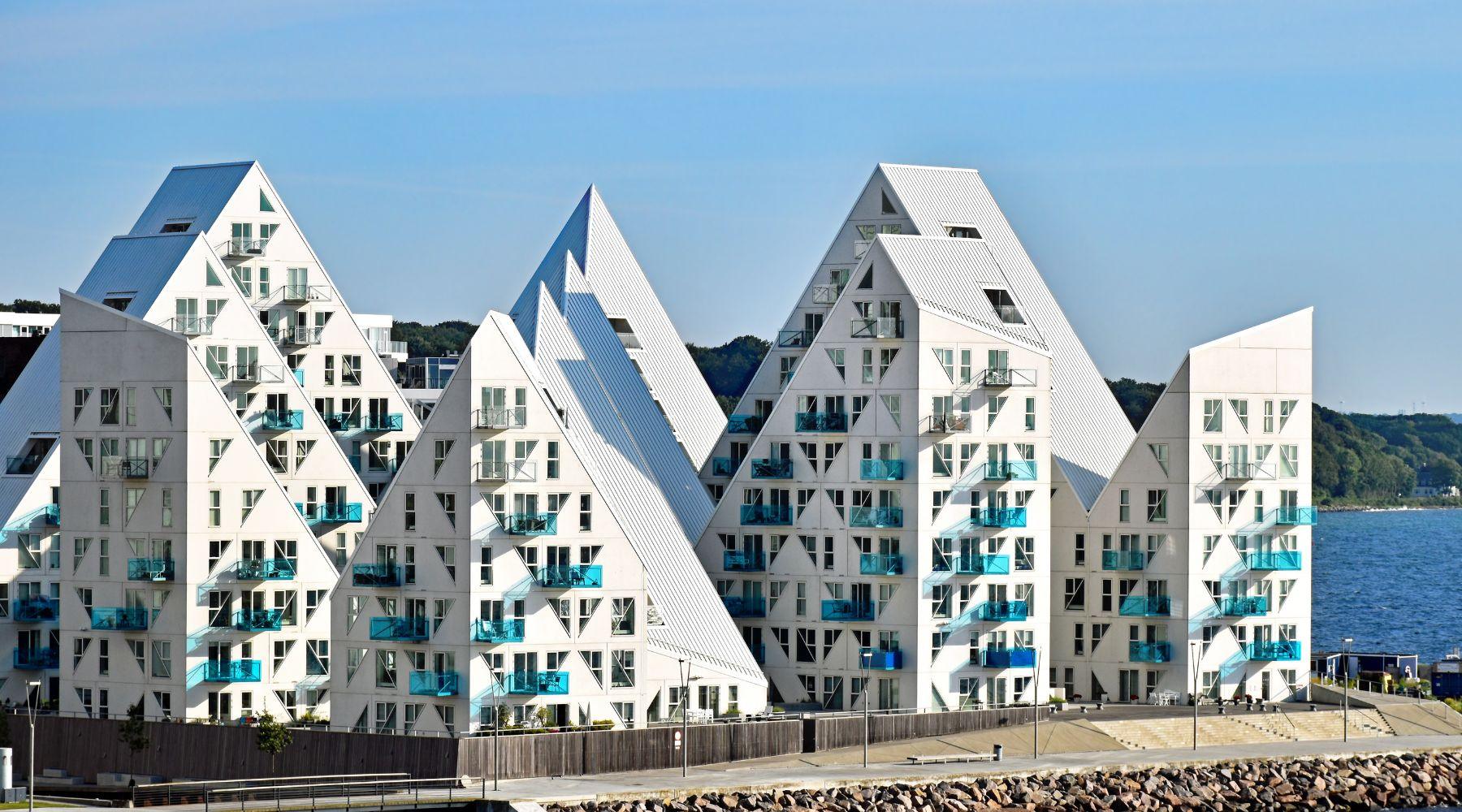
The 10 Most Iconic Danish Designs
Despite having a population of under six million, Denmark has had a huge influence on the world of design. Discover the ten most iconic Danish design pieces—and how their aesthetics and ethos influence our Scandinavian design duvet covers.
Faaborg Chair – Kaare Klint, 1914

Chair designed by Kaare Klint in 1922 for Thorvaldsens Museum on display in the Danish Design Museum in Copenhagen, Denmark
Kaare Klint is often considered the father of modern Danish design, and while his 1933 Safari chair is arguably more popular today, his Faaborg Museum chair launched Danish design as we know it—simple, functional, and free from superfluous ornamentation. Klint used oak burl wood, which allowed the natural beauty of the grain to stand out. Klint would go on to establish the department of furniture design at Copenhagen’s Royal Danish Academy of Fine Arts—the alma mater of Arne Jacobsen, Verner Panton, and Sydney Opera House designer Jørn Utzon.
Pelican Chair – Finn Juhl and Niels Vodder, 1940

Pelican Chair (1940) designed by Finn Juhl in the lobby area of Swedbank headquarters in Sundbyberg. Photo by Sinikka Halme.
Finn Juhl also trained at the Royal Danish Academy but studied architecture rather than furniture design. Most of Juhl’s iconic chairs, therefore, were made in collaboration with cabinet maker Niels Vodder, whose work often appeared to defy the laws of physics. The sweeping lines and stubby round legs of the Pelican Chair caused quite a stir—when early versions appeared at the Cabinetmakers’ Exhibition in 1939, the trade magazine Arkitekten described them as resembling “tired walruses.” Despite its instant fame, the chair proved too controversial for its time and did not enter commercial production until 2001—12 years after Juhl’s death.
Beolit 39 – Peter Bang and Svend Olufsen, 1938

"Beolit 39" radio, 1939, Bang & Olufsen, bakelite and carbamide
Bang & Olufsen was founded in 1925 when Peter Bang and Svend Olufsen started making radios in the attic of the Olufsen family home. Eventually, Bang’s insatiable curiosity led him to experiment with Bakelite, a lightweight and durable plastic developed by the Belgian chemist Leo Baekeland in New York. The result was the Beolit 39—the first product made entirely from Bakelite and with a speaker grill inspired by Bang’s father’s Buick Y car. It was an instant success, and the Beolit name still applies to Bang & Olufsen’s modern designs—even though the days of Bakelite are long gone.
CH24 – Hans J. Wegner, 1949

Hans Wegner's Wishbone Chair (1949). Armchair designed by Hans Wegner, manufactured by Carl Hansen & Søn Møbelfabrikk in 1950. Made of beechwood. Photo by Nasjonalmuseet for kunst, arkitektur og design.
The CH24—popularly known as the Wishbone Chair—is a staple in any Danish design-lover’s home but its origins lie farther east: the chair’s Y-shaped back, made from steam-bent blond wood, was inspired by the chairs of China’s Ming dynasty. Hans Wegner trained as a cabinetmaker rather than a designer; the CH24’s unadorned frame and woven paper seat reflects his respect for natural materials.
Our Scandinavian-style duvet covers use all-natural organic linen, which is made from flax grown in Belgium, France and the Netherlands. Just as Wegner’s designs carefully preserve the qualities of natural wood, European flax is pulled from the ground rather than cut to preserve its length and ensure that you receive the highest-quality organic linen bedding.
Egg Chair – Arne Jacobsen, 1958

The Egg Chair by Arne Jacobsen at the National Nordic Museum in Seattle, US.
In the mid-1950s, Scandinavian Airlines System (SAS) hired Danish architect Arne Jacobsen to design Copenhagen’s Royal Hotel. The famously detail-oriented designer supervised not only the hotel’s architecture but every aspect of its design, from the restaurant tableware to the airport shuttle bus. The most distinctive of these creations was a curved wing chair called Ægget, or Egg. The chair was made from lightweight foam—which allowed cleaning staff to move it—and it’s still in production today.
EM77 Vacuum Jug – Erik Magnussen, 1977

The EM77 coffee jug by Erik Magnussen. Photo by Christos Vittoratos.
The Stelton brand is best known for Arne Jacobsen’s Cylinda-Line range of sleek, stainless-steel homeware. However, Stelton’s most famous piece—the EM77 coffee jug—was designed not by Jacobsen but by Erik Magnussen, six years after Jacobsen’s death in 1971. Stelton owner Peter Holmblad hired Magnussen to capitalize on the growing trend for vacuum coffee jugs; the result stays faithful to Jacobsen’s vision while adding a rocker stopper, a new handle shape, and a glass filler that could keep hot drinks at 80°C for at least five hours.
PH5 Lamp – Poul Henningsen, 1958

Lighting designer Poul Henningsen’s PH5 lamp. Image by Richard Hubar.
Rumor has it that lighting designer Poul Henningsen’s office was painted entirely black so that he could see how different lamps affected the spread of light across walls and ceilings. The PH5 lamp was the result of decades of experimentation with materials, colors, and angles to produce even illumination without glare; today, most Danish design lovers’ homes contain at least one PH5.
Like Henningsen’s creations, our European bedding is crafted with the utmost attention to detail—corner ties keep your duvet in place at night, and each stitch and button meets the rigorous standards of OEKO-TEX.
Margrethe Bowl – Sigvard Bernadotte and Acton Bjørn, 1954

Margrethe Bowl by Sigvard Bernadotte and Acton Bjørn.
A shortage of materials in the aftermath of World War II meant that designers had to use what was available. Danish brand Rösti identified melamine as a heat-resistant, lightweight plastic that was ideal for kitchenware. Rösti enlisted Swedish prince (and designer by trade) Sigvard Bernadotte and Danish architect Acton Bjørn to create designs in melamine. The result was a practical mixing bowl named after Bernadotte’s niece, Margrethe—now Queen Margrethe II of Denmark.
Panton Chair – Verner Panton, 1959

Panton Chair by Verner Panton. Photo by Peter Guthrie.
In the 1950s, Verner Panton was fascinated with the mass-production potential of plastic—then a new material—and set out to make the world’s first single-piece chair. His design was rejected by more than 15 manufacturers before the Swiss manufacturer Vitra decided to take a chance on Panton’s vision; four years and ten prototypes later, the Panton chair was born. Panton and Vitra continued to tweak the design several times until Panton’s death in 1998.
LifeStraw – Mikkel Vestergaard Frandsen, 1996

LifeStraw by Mikkel Vestergaard Frandsen
The life-saving LifeStraw is perhaps the best-known example of Danish design for good. LifeStraw came about when entrepreneur Mikkel Vestergaard Frandsen collaborated with US nonprofit The Carter Center in an effort to eradicate the waterborne guinea worm disease—an effort that, over 26 years, reduced the worldwide number of guinea worm cases from 100,000 to 27. The LifeStraw’s porous fabric filter strains out bacteria, parasites, and harmful chemicals, leaving pure, clean drinking water.
Like the LifeStraw, our organic linen duvet covers appear simple, yet have properties to rival the most advanced technical fabrics. Linen is naturally thermoregulating—it keeps you cool when it’s warm, and warm when it’s cool. It’s also hypoallergenic and antibacterial, ensuring a comfortable night’s sleep and better overall health.
What’s your favorite Danish design? Do you have any Danish design classics in your home? Let us know on Instagram, Pinterest, Facebook, or Twitter!






Leave a comment
This site is protected by hCaptcha and the hCaptcha Privacy Policy and Terms of Service apply.